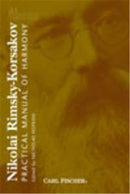| 作曲者 | Nikolai Rimsky-Korsakov (1844-1908)・ニコライ・リムスキー=コルサコフ |
| タイトル | Practical Manual of Harmony |
| 出版社 | Carl Fischer Music・カール・フィッシャー |
| 品番 | HL9780825856990 |
| 校訂者 | Nicholas Hopkins |
| 形状 | 144 ページ・15.2 x 22.9 cm・170 g |
| 出版年 | 2001年 |
| 出版番号 | TXT2 |
| ISBN | 9780825856990 |
Rimsky-Korsakov wrote this book for his harmony students at the Imperial Chapel in St. Petersburg because of his dissatisfaction with other harmony methods of the time. His methodology in this book favors the establishment of a comprehensive foundation in tonal harmony (making it ideal as a pedagogic tool), over an exhaustive analysis of harmonic tendencies in Western music. This edition of the Practical Manual of Harmony, re-issued more than one hundred years after its first printing, preserves the original content of the 1885 edition, yet adopts a fresh layout and design to better enhance its organization. The book was a success in music programs at the end of the nineteenth century. Its content will produce equal success in the music programs of today and beyond.
Section 1: Preliminary Notions
Chord of the Seventh
Natural and Altered Modes (Primary and Secondary Chords)
Natural and Altered Modes (Primary and Secondary Chords)
Relationship of Triads
Movement of Voices
Doublings, Close and Open Harmony, Melodic Position of Triads
Harmonic and Melodic Connection of Triads
Forbidden Progression and Steps
Certain Exceptions in the Rules of Voice Leading
Section 2: Harmonization of Chords within a Single Tonality
Consonant Combinations
Consonant Combinations
Consonant Combinations
Consonant Combinations
Consonant Combinations
Consonant Combinations
Simple Complete Cadences: Authentic and Plagal
Compound Cadences with the Progression of the Subdominant and Dominant
Compound Cadence with the Six-four Chord on the I Degree
Passing Six-four Chord
Semi-Cadence (Harmonic Phrase)
Leaps of a Fourth or Fifth in the Melody and Middle Voices
Leaps of a Third in the Melody
Leaps of a Third in the Bass
The Sixth Chord of the Diminshed Triad on the VII Degree
The Root-position Triad and the Sixth Chord on the II Degree
The Root-position Triad on the VI Degree
The Root-position Triad on the VI Degree
The Root-position Triad on the III Degree in Major
The Root-position Triad on the III Degree in Natural Minor (Phrygian Cadence, Second Form)
The Root-position Triad on the VII Degree in Natural Minor (Phrygian Cadence, Second Form)
Harmonization of Chorales (Without Modulation)
The Minor Subdominant Triad and the Sixth Chord on the II Degree of the Harmonic-Major Mode
Dissonant Combinations (The Dominant Seventh Chord in Root Postion)
Inversions of the Dominant Seventh Chord
Leading Seventh Chords on the VII Degree (Half-diminished and Diminished)
The Seventh Chord on the II Degree and Its Inversions
Particular Forms of Plagal Cadences on the II and VII Degrees
Application of Seventh Chords to the Harmonization of Chorales
The Chord of the Ninth
The Relationship of All Triads in a Mode
The Relationship of All Triads in a Mode
The Relationship of All Seventh Chords in a Mode (Sequence with Seventh Chords)
Supplement (Free Use of All Chords of the Scale)
Section 3: Modulation
Near Keys, or Keys in the First Degree of Relationship
Modulation without Chromaticism
Indirect Methods
Use of the Modified Triad on the IV Degree in Melodic Minor
Modulation Directly through the Tonic Triad of the Subsequent Key
Chromaticism and Free Progressions (Cross Relation)
Chromatic Modulation
Use of the Modified Triad on the IV Degree in Melodic Minor
Transitions and Digressions
Use of Modulations in Harmonizing Melodies
The Second Degree of Relationship (Modulation Plans)
Exceptions
Perfect Modulation
Imperfect Modulation
Remote or Distant Tonalities
Organ Point
Section 4: Melodic Figuration
Passing Notes
Passing Notes
Passing Notes
Auxiliary or Embellishing Notes
Suspensions
Suspensions
Suspensions
Suspensions
Strict Melodic Figuration
Figured Chorales and Harmonization of Melodies Containing Melodic Figuration
Free Melodic Figuration
Harmonic Figuration and Figuration of the Organ Point
General Rule
Chromatically Modified Chords
False Dominant-seventh Chords and False Diminished-seventh Chords
Major Triad on the Lowered II Degree ("Neapolitan Sixth Chord") and the Dominant Seventh Chord with the Lowered Fifth
Chords with an Augmented Fifth
Chords with an Augmented Sixth
Means for Enharmonic Modulation
Enharmonicism of Chords with an Augmented Sixth
Enharmonicism of the Diminished-Seventh Chord
Enharmonicism of the Augmented Triad
False Progressions
False Cadences
False Progressions of Dominant Seventh Chords
Application of False Progressions to Sudden Modulation
Harmonization of Chorales
Conclusion
Exercises



